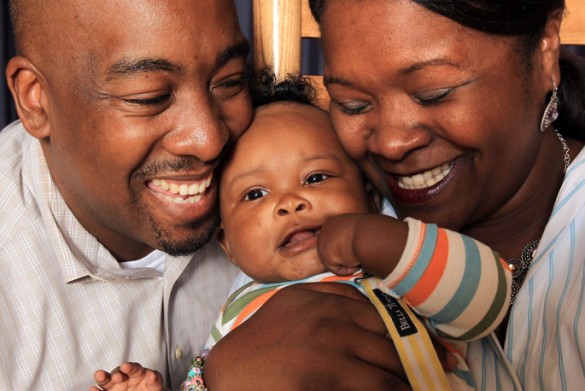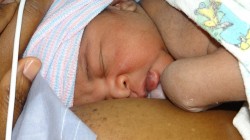
Robert and Michele McClellan expected the experience of their infant son’s birth via cesarean section to be like that of other women who had had the procedure — unable to witness their son’s exit from the womb and for him to be immediately whisked away.
But the day of Michele McClellan’s planned C-section brought a pleasant surprise, a family-centered cesarean, also referred to as a natural cesarean. Not only did the couple watch their son, Robert McClellan III, enter the world, but Michele McClellan also got to hold him skin-to-skin on her chest while the surgeons finished her procedure on the other side of a curtain.
“I tell people about it all the time,” said Michele McClellan. “You too can have a very happy birth of a child even with a C-section. It is possible.”
Since January, Vanderbilt has been offering family-centered cesarean sections to give families the opportunity to view the birth of their baby, if they desire, as well the chance to hold and bond with the baby in the operating room shortly following birth. More than 170 families have taken advantage of the program and been able to have skin-to-skin contact with their newborn.
“Family Centered Cesarean Birth (FCCB) is not hard to introduce at any hospital,” said Bennett Spetalnick, M.D., medical director of Labor and Delivery and assistant professor of Clinical Obstetrics and Gynecology.
“Pediatrics, Obstetrics, nursing and doctors are all looking for ways to enhance parents’ experience in the OR. With FCCB we have had rapid buy-in from all the participants and are achieving a truly enhanced level of patient satisfaction without putting mom or baby at any risk.”
Still a relatively new phenomenon in the United States, the family-centered cesarean is a way to honor the childbirth experience for families, but in a cesarean setting.
“There are a lot of meaningful things that happen in a vaginal birth that kind of get taken away from you in a cesarean birth, and that includes being able to witness/watch the birth of your child and see that moment of birth, which is so emotional. Another one is being able to hold your baby right away and bond and nurse,” said Sarah Starr, M.D., assistant professor of Clinical Anesthesiology, who works with obstetrics patients.
“It is a really important commitment of Vanderbilt because of the Baby-Friendly Hospital Initiative. One of the key things is doing skin to skin right away.”

The Baby-Friendly Hospital Initiative is a global program that encourages and recognizes hospitals and birthing centers that offer an optimal level of care and environment for infant feeding. Vanderbilt’s Departments of Pediatrics and Obstetrics and Gynecology signed on for the program about two years ago seeking designation as a Baby-Friendly Hospital, which requires a four-phase plan and on-site approval.
Studies show skin-to-skin bonding in the first hour after birth between mother and child and father and child can increase the chance for successful breastfeeding.
Vanderbilt formed a committee in 2011 to consider the best protocols to look at the health, safety and infection control of the mother and baby while offering the ultimate birth experience for families.
To ensure infection control, Vanderbilt began using a special curtain with a window that keeps the surgical area sterile during the C-section.
When the baby is slowly “walked out” of the womb, a flap covering the window is lifted at the right moment for mom and dad to view the birth, and then is closed again.
The program also included a new position for a transition nurse who helps monitor the mother and infant during skin-to-skin contact.
“The family-centered cesarean eliminates a lot of the fear that goes along with a C-section,” said Lacey Burke, R.N., transition nurse for the Family-Centered Cesarean initiative.
“Part of the fear is not just the fact that you’re going through surgery, it’s the fear that ‘my baby is being taken away from me and I don’t know where my baby is going.’
“Our goal is to keep moms and babies together so that it takes a lot of the medical feeling out of the experience. It feels friendlier on so many levels. You’re here to go through a life event, and we’re just trying to make it a better experience for all,” Burke said.
For the McClellan family, the family-centered C-section was a surprise on delivery day, Jan. 21. Michele McClellan knew she would have to have a C-section because of a previous abdominal surgery.
“Lacey came in and presented this as an option to us,” said Robert McClellan.
“It was one of the best surprises we had had that day,” said Michele McClellan. “I appreciate her for just coming in to offer it to us. If you have to have a C-section this is the way to go. I don’t know what we would have done without it.”












